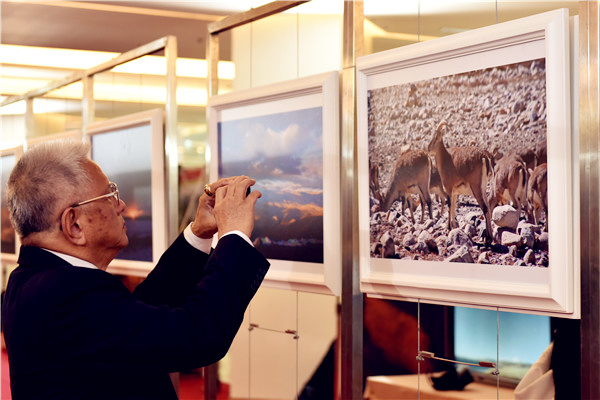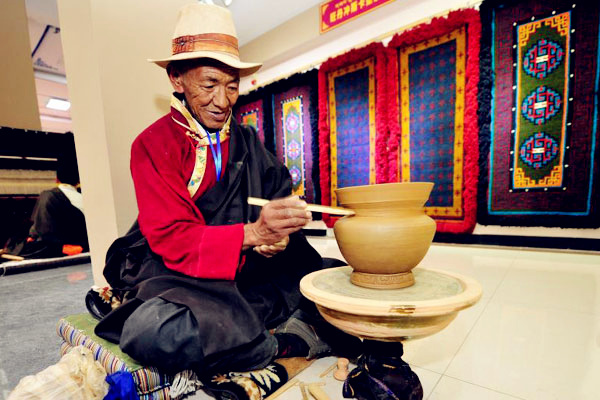By Tom McGregor, CCTV.com Panview commentator and editor
Editor's Note: CCTV.com Panview presents 'China Cares' — series of special coverage on China's rural reforms, charities and comprehensive efforts to help those in poverty unlock their potential for success.
The residents of China's southwest Tibet Autonomous Region hold a long and rich cultural history, while a large majority of them have a deeply-ingrained faith in Tibetan Buddhism.
The Tibetan culture appears colorful and elegant, when it comes to its sacred scriptures, Buddha statues and Thangka art. Many Buddhist monasteries hold prominent influence and in their respective local communities, serving as spiritual centers for its people.
Accordingly, the Tibet Autonomous Region government has launched a campaign to digitalize over 100,000 Tibetan antiques into virtual record-books, which started in 2013.
1st census of antiques
According to Beijing Review magazine, China's Tibet Autonomous Region government has conducted a comprehensive digitalization of 105,494 items from 825 sites that records information and the state of preservation in its record books.
The regional cultural heritage bureau had directed the project. Beforehand, a team of researchers and archivists had already registered much of the information on each item into hand-written record books that were scanned and photographed.
The documentation was detailed and digitalization had taken it a step forward to ensure all information can be viewed by the public.
It served as the first digital census of Tibetan antiques conducted by the government. Tibet boasts of plenty of historical resources with 1,295 registered institutions, 90 percent of them are temples.
Tibet photos roadshow
Government officials working in Tibet have also launched a global campaign to showcase amazing photos to highlight the beauty and grandeur of southwestern China.
The China Daily reports that in late December 2016, The Chinese Consulate in Bangkok had hosted a Tibet photo exhibition in Thailand’s capital city.

(A visitor takes a photo of an exhibit at the Bangkok show. Photo from Xinhua)
The 'Digital Art Exhibition on Tibetan Cultural Heritage' was also sponsored and jointly organized by Xinhua and China Mobile for five days at Siam Paragon Mall.
Visitors could stroll around and look at photos displayed on the walls or they could put on VR headsets to look at Tibetan scenery with a voice narrator to explain what they were seeing.
Willy Mayor, an Australian citizen who lives in Thailand, was a visitor to the photo exhibit and spoke to China Daily.
"I must say it's absolutely fantastic," Mayor said, "I've seen lots of photographs of Tibet. I have been to Tibet myself, but these are the most beautiful pictures I've ever seen about Tibet."
Augmented reality experience
Tibetan Buddhist monks from the Samye Monastery were chief archivists and landscape scenery photographers for the photos uploaded into VR headsets at the Bangkok exhibit.
The monks worked closely with Ming Dajun, chief of Xinhua's Bangkok bureau and director of the project.
"The augmented reality experience, let visitors open an APP to scan selected postcards to learn where the photos on cards were taken and their stories," said Ming.
China's then ambassador to Thailand, Ning Fukui had attended and encouraged the Thai people to visit Tibet as well.
Monks play leading roles
The digitalization of Tibetan antiques relied heavily on Tibetan Buddhist monks. At the Sakya Monastery, more than 50 Sakya Buddhist-sect monks out of 140 living there were involved in daily works of the project.
They started digitalizing in September 2017, according to China Economic Net. They are responsible for placing antiques found in the monastery to be first placed on a table.
The monks and other researchers are then required to investigate each item on the table by weighing, measuring, photographing and listing a digital number for each antique item that all get stored in data on computers with detailed descriptions written in Mandarin and Tibetan languages.
They have archived 26 types of archives, including 7,000 Buddha statues, 1,000 Thangkas, 1,000 musical instruments used in a Buddhist mass and hundreds of scriptures recorded during the first round of digital arching in 2015.
"The artwork in the monastery is invaluable," said Sonam Wangden, monk leading the project. "They show the skills in craftstmanship and shed light on the essence of Tibetan culture."

(A handicraftsman displays his pottery skills at an intangible heritage exhibition in Tibet on June 12, 2015. File Photo: Chinanews.com)
He added, "Identifying and understanding them is vital to long-term preservation."
Respecting Tibetans and their culture
For centuries the region of Tibet had long been mired in poverty and its cultural relics were stored in Tibetan Buddhist monasteries, so local residents could not view them without special approval from monks.
Yet in recent decades, the Tibet Autonomous Region has witnessed high economic growth rates and rapid development. Tibet has been modernized with major infrastructure projects completed, such as highways and airports that have connected the isolated region with the rest of China.
Now, Tibet is a special place for tourists and to keep the regional economy vibrant, it's imperative for local communities to preserve their rich heritage and antiques. Accordingly since 2002, Beijing has spent over RMB100 million (US$15 million) on renovations of Tibetan Buddhist monasteries and to preserve Thangka artwork.
China cares about Tibetan culture and this explains why so many tourists have visited the region to observe beautiful natural landscapes and to tap into its unique culture and heritage.
(The opinions expressed here do not necessarily reflect the opinions of Panview or CCTV.com. )

Panview offers a new window of understanding the world as well as China through the views, opinions, and analysis of experts. We also welcome outside submissions, so feel free to send in your own editorials to "globalopinion@vip.cntv.cn" for consideration.
















